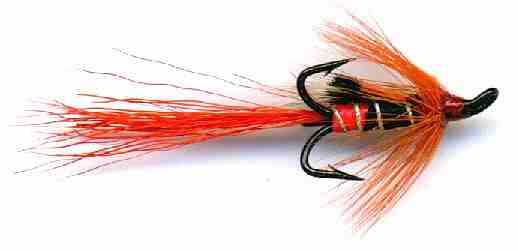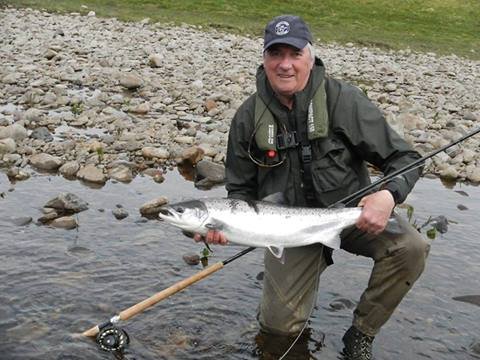Ally's Shrimp Treble Hook Salmon Fly
Alistair Gowans created the Ally's Shrimp salmon fly pattern to simulate the translucent, shrimp like crustaceans he had observed in trawler catches. This little shrimp is one of the great patterns of all time.

SALMON TREBLE HOOK FLY PATTERNS. Hook size 8 12 - $US each
Alistair created the Ally's Shrimp salmon fly pattern in 1981 and was first publicised in 1988. It is one of the most popular Atlantic Salmon flies. This little shrimp is one of the great patterns of all time. The long flowing tail produces motion that gives the illusion of life. It is a river fly for all seasons. It is very successful for salmon on large rivers. These crustaceans can be found in most rivers, lakes and reservoirs. They form a large part of the trout's menu of edible fast food. Some natural colored shrimps turn orange-brown during the mid summer mating season.

A deep fished, artificial shrimp fly pattern can be a killer, especially when it is fished to imitate the shrimp's darting, stop-start, motion. This type of 'sink and draw' is easy to reproduce when you fish with a weighted shrimp on a floating line. Cast the fly and let it sink until you think it is at, or near, the bed of the river or lake. As you retrieve the line the shrimp fly will rise up towards the surface. Stop and the shrimp will dive back down to the bottom. A shrimp fished with six inch pulls followed by two second pauses can be very tantalizing to a trout. If you should fail to get results try longer pulls at greater intervals. Alistair 'Ally' Gowan is a full time professional flyfishing instructor, author and photographer, he demonstrates fly casting with single and two handed rods in a number of countries and at various fly fishing shows.
He has a vast knowledge and experience on the subject of fly fishing for salmon, sea trout and trout from a flyfishing career spanning over 50 years. he is based in Pitlochry, Perthshire in the Highlands of Scotland. He writes articles for a number of different fly fishing magazines. He is an expert Spey caster and instructor. He teaches underhand, roll and overhead Spey casting. He holds many UK fly fishing instructors qualifications but he is also one of the founder holders of the AAPGAI Masters Qualification in both disciplines. He travelled to Seattle and and became the first British instructor to pass all three of the demanding FFF certifications at one event. The Ally's Shrimp was voted 'Salmon Fly of the Millennium' by EMAP readers and came high up in the listings of the 'Worlds best Flies' by NASF.

Ally's Shrimp was designed after Alistair went out on a Trawler Fishing boat. He was looking at stocking up his freezer with Lobster but it was the semi translucent shrimps that caught his eye. He had not seen them in the Scottish rivers or along the coast before. He realised that these were the creatures that the Atlantic Salmon feast upon to build up their body weight before they come back to their spawning grounds in the freshwater rivers. He reasoned that if he could design a fly that appeared to look similar to the salmon's favourite deep water food they could be tempted to take a bite when they came across it nearer land. He needed to mimic the naturals dark gut so he used black floss and the for the rear section of the hook shank he used red floss to match the body. Alistair need to imitate the the shrimps eyes which are half way down the body. He settled on orange Golden Pheasant tippets and place the black ends in the correct location to give the impression that this shrimp fly had black eyes. The orange collar hackle would cocoon the fly as it was fished through the water and produce a shrimp like outline. The Shrimps feelers were imitated by the incorporation of long strands of dyed bucktail hair. When you see shrimp in the supermarket or cooked and on your plate they are curved. The Ally's Shrimp salmon and steelhead fly mimics the shrimp when they are in fast mode trying to swim away from a potential predator. The shrimp thrust out their powerful tails to provide quick forward propulsion as they straighten their body.
There is often a lot of discussion in the pub after a days fishing on the subject of whether or not long winged flies encourage salmon to "take short". For many years fly patterns the salmon have been tied with wings that only extended the length of the hook. They did not go much beyond the hook bend. The belief was that if a salmon took the fly it would take the hook into its mouth as well. This worked a lot of the time, but some salmon still got off the hook. An experiment was conducted using a flying treble fly pattern. For those who do not know what this is, try to imagine a single fly with the trailing treble. After 100 fish were caught it was found that four them had been hooked on the trailing treble and the rest on the single hook front fly. Why bother with the trailing treble if most of the takes were on the front fly.
There is a temptation to dress a fly short on a longer hook. There are a few problems with this approach. The larger the hook, the harder it is to set correctly in a salmon's mouth and when it is hooked the leverage on these larger hooks usually ends up with a lost fish. I find small hooks are easier to set. When an angler strikes and misses a hook up the commonly held view is that the fish was taking short, but this is not necessarily correct. From my observations on how salmon take flies. I have noticed that some will come up to the fly, touch it with their nose and turn away. It looks like they are having a sniff to see if it smells edible. Others will come up to the fly and turn, touching the fly as they do so. This sometimes results in the occasional foul hooked fish. Other salmon engulf and then turn with the fly quite deliberately, in which circumstances your fish is normally firmly hooked. I find that salmon either take the whole fly or don't take it at all.
The reason salmon shrimp fly patterns like the Ally's Shrimp or General Practitioner work so well is because of the simulated natural movement of their long mobile hackles and bright fish eye catching bodies. Some salmon fishermen blame these type of flies for the salmon taking short if they raise a fish and fails to hook it. If your local salmon are moving to a hook size 6 shrimp pattern, but are not taking it then change the hook size down to a size 8 or 10. Do not change the dressing style of your shrimp pattern by removing the bits that extend over the hook length. These are the fibers that wiggle around in the water on the retrieve and suggest to the lurking salmon that your imitation fly is alive and good to eat.
When a salmon river is in spate the normal clear water turns into a muddy coffee covered liquid. If the salmon can't see a fly then it certainly won't take it. Another advantage using a bright fly on a floating line is that I can see the fly drift around and can usually spot the fish take it. I have found that Salmon either engulf the fly completely or don't take it at all. I try to always hold my rod at an angle of 45°. I believe this allows the fish to take the fly, turn, straighten any slack, and then pull the rod down. All I then do is lift into the fish.
ORIGINAL ALLY'S SHRIMP FLY PATTERN RECIPE
Hook = partridge code X2B treble
Tail = hot orange bucktail (with four strands of pearl crystal hair) just longer than the same length of the hook
Body = rear half red floss, front half black floss. Gold oval tinsel ribbing
Underwing = top and bottom natural grey squirrel tied flat and extending to the bend in the hook (this is the translucent body imitation)
Wing = Golden Pheasant tippet black ends aligned and extending to the hook barb (the black bits are the shrimps eyes)
Hackle = Hot Orange cock to match the bucktail colour. Tied by the tip and wound as a collar then dressed back. Hackle length should extend to the tippet ends
Head = red
SHRIMPS & PRAWNS
There are about thirty species of shrimps (the smaller ones are sometimes referred
to as Prawns in Britain) in the North Atlantic Ocean. The most numerous is the
Northern or Pink Shrimp (Pandalus borealis). It ranges from the Gulf of Maine,
across the Atlantic and into the Barents, Norwegian and North Sea. It is pale
scarlet and has a hard outer shell with long antennae and large dark eyes. It
can swim rapidly over short distances because of the appendages on its tail that
act like paddles. The females migrate to shallower costal areas just prior to
spawning.
These shrimps can live for more than five years. They are one of those strange animals that are both sexes. It is a hermaphrodite. It contains both male and female reproductive organs. The Northern Shrimp is male until it spawns for the first time when it is about three years old and then changes sex into a female. Because females have lived longer than the males they are generally bigger than the males. European salmon anglers have been using shrimp imitations for years. It is only recently that North American salmon fly fishers have started to widely use shrimp flies. A practice that should be encouraged as these flies can give hours of good sport. Steelheads, Chinooks, Chums, Char, Coho and Sea Trout will feed on shrimp and prawns when available. These fish often retain the search image of these crustaceans long after they leave the Ocean and enter freshwater. These are must have flies for Alaska, Kamchatka, British Columbia and lower 48.
SCOTTISH FISHING TRIP
I was fishing in Scotland one year when the water levels were excellent and there was a good supply of grilse and summer salmon. For some reason they were not coming to investigate my flies cast on a full floating line. They seem to be shy of flies fished on the surface. I experimented and found that they would rise to a fly presented just a few inches below the surface. Rather than fishing a plastic tube fly, I switched to a copper tube fly to obtain the necessary depth. The other option is to switch to a sink tip line. In conditions where the water level is lower, then a floating line presenting a small hook size 10 with a trailing hair tail profile works fine.
I carry three detachable sink tips in my jacket pocket. They vary between gentle and fast sinking. This allows me to experiment and find the correct depth that the salmon are taking flies. Even though the water temperatures were warm because of the good weather I decided to try a sink tip as I had no takes on my normal presentations. I tied on a size 10 Ally's Shrimp treble, with its trailing orange tail. I tried it on the fast sink tip first with no success. I then swapped it to a gentle sink tip and on my fourth cast, I had a good strong fresh salmon take. It was a boisterous fight but I walked the fish out up to the bar of shingle near the stream head. It was a nice fresh 9lb cock fish carrying sea lice. A 5lb, a 7 1/2lb and an 8lb salmon followed this success. There were not many "resident" salmon in many of the pools. The all seemed to be occupied by the new fish fresh from the sea. The water and air conditions seemed to be ideal for a floating line approach but I learnt that in these conditions where the available fish were just passing through, the subsurface approach was King.
CUSTOMER'S COMMENT
I would add that I see so many salmon fishers striking, or as you correctly say, 'lifting into the fish', too quickly, thus pulling the fly out of the mouth while the fish is still facing upwards. Do what the Victorians did: feel the take, say 'God Save the Queen' to allow the fish to turn down, then lift into it! Easy, except if you're a republican! Gregor Fulton McGregor HK
CUSTOMER'S COMMENT
Whilst fishing on the Kola river in Russia the most successful fly of the whole week was the Ally's Shrimp. It caught fish steadily throughout our week. It seemed to succeed best in all situations. The salmon in these rivers are very active bright-silver summer fish that are fresh off the tide. Many of them were still covered in sea lice. I found they tend to snap at the fly as it comes across their nose. Green Highlanders and Bombers also worked. The barbs of the flies have to be snipped off if you do not want to fall foul of the Russian Fishery Inspectors. Gary Church, New York
CUSTOMER'S COMMENT
The Miracichi, one of New Brunswick's legendary Atlantic Salmon Rivers is my fishing heaven. I had a dream season last year. One morning I released my four fish limit of two salmon weighing 30 pounds and two others of 21 and 18 pounds all caught on your Ally's Shrimp. What a great fly. Stan Quarry. Maine.

